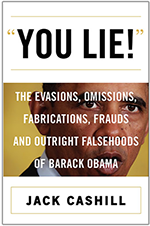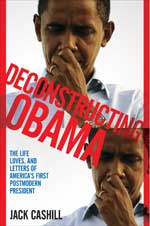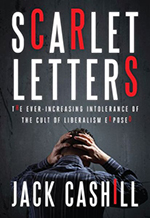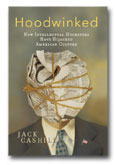Black Lives Matter Only at MU
Order Jack Cashill's newest book,
Scarlet Letters
___
Get your copy of Jack Cashill's book, "You Lie!"

___
Get your copy of Deconstructing Obama

___
Jack Cashill's book:
Hoodwinked: How Intellectual Hucksters have Hijacked American Culture
© Jack Cashill
WND.com - November 11, 2015
On November 3, Jonathan Butler began his hunger strike at the University of Missouri. His stated goal was to assure that black students felt “safe and included on campus.”
As to blacks beyond the campus, let alone whites, Butler expressed no particular interest. He should have. If recent averages held, five black Missourians would have been murdered in the state during his hunger strike.
Many other young black men saw their futures evaporate during that same period. The day after Butler began his strike, Lee’s Summit, Missouri, police arrested two eighth-graders for the stabbing death of a 43-year-old white woman, a story that did not get the tiniest fraction of the airplay Butler’s got.
These deaths held no interest for the state’s politicians.
“Racism and intolerance have no place at the University of Missouri,” said Democratic Missouri Governor Jay Nixon in his desperate effort to align himself with the young neo-puritans very publicly pouting on campus.
The MU Police got the message. To protect the campus snowflakes, they sent out a campus wide email—not a parody—asking students to call the police “immediately” if they “witness incidents of hateful and/or hurtful speech.”
As is by now well known, blacks on campus have been under siege. The president of student government said that people in a passing pickup truck shouted racial slurs at him. A drunken white student made a “hurtful” remark to members of the Legion of Black Collegians (LBC).
Most hurtful of all, someone reportedly smeared feces into a swastika in a dormitory bathroom--though there is no photographic evidence of the same and no connection to anything black.
______________________________________

______________________________________
With MU’s baby seals in such imminent peril, Butler went on his hunger strike, the black half of the football team walked out, the university president and chancellor resigned, and the national media swooned in self-righteous angst.
Meanwhile, in Missouri’s real world, black people were getting murdered in record numbers, and no one seemed much to care.
Earlier in 2015, St. Louis’s Riverfront Times, an alternative publication, reported that “if you're black and you live in Missouri, you're seven times more likely to be murdered than non-blacks and twice as likely to be murdered than blacks in other states.”
The figures came courtesy of the Washington D.C.-based Violence Policy Center, which used the numbers from 2012, the last year for which comprehensive statistics were available.
In that year, 247 blacks were murdered in Missouri alone. The Violence Policy Center did not record how many had heard “hurtful speech.” The fact that Missouri has ranked highest or second highest in black murder deaths for five consecutive years made the “hurtful remarks” category seem a bit trivial everywhere but on campus.
In the years since 2012, the MU campus excepted, life has become even more perilous for Missouri’s African Americans. The reason has to do with the events in Ferguson, Missouri—about 90 minutes from MU—on August 9, 2014.
On that day, the nation’s progressive activists and their enabling media finally chose to notice one of the 250 or so Missouri blacks killed that year.
They noticed because Michael Brown was the extraordinary black Missourian to be shot and killed by a white man, in this case Ferguson cop Darren Wilson. All of a sudden, black lives mattered.
White lives did not matter a whit, Wilson’s most notably. To advance their various causes, the activists and the media flagrantly lied about the facts surrounding Brown’s death.
If nothing else, they proved that “liberalism” of the Atticus Finch school is dead. Today’s liberals were no longer the ones standing outside the jailhouse, shotgun reluctantly in hand, protecting the “mockingbird” within.
No, they were the mob in front, clamoring for the mockingbird’s head. In this case that mockingbird was Wilson, so transparently innocent of murder that even Eric Holder’s racist DOJ was forced to clear him.
The MU narcissists found the Ferguson lies much more “empowering” than the truth. After the shooting, they staged a “die-in” protest on campus to honor Brown’s benighted memory.
“That was the first time I got involved in activism,” one student told the AP this week. “I never felt that unity before, that kind of energy. It was very empowering, and it planted the seeds that students can challenge things.”
Meanwhile, back in the mean streets of St. Louis, black young men and women did not need to stage die-ins. They got to experience the real thing in new record numbers.
It was the perps who felt empowered. As to the cops, like the administrators at MU, they were damned if they did and damned if they didn’t. So they didn’t.
As political science professor Ernest Evans has been at pains to document, the Ferguson effect is real. In the three months before Brown’s death, St. Louis averaged nine murders a month. In the five months afterward, the city averaged eighteen homicides a month.
The effect reached cross-state as well. Here in Kansas City, there were forty-one homicides in the first eight months of 2014, an average of five a month; in the last four months of 2014 there were thirty-nine homicides, an average of nearly ten a month.
The trend continues, and as Evans notes, the Ferguson effect “has taken place almost exclusively in black neighborhoods.”
But forget about all that. Did you know that in 2010 someone scattered cotton balls around MU’s black cultural center?



